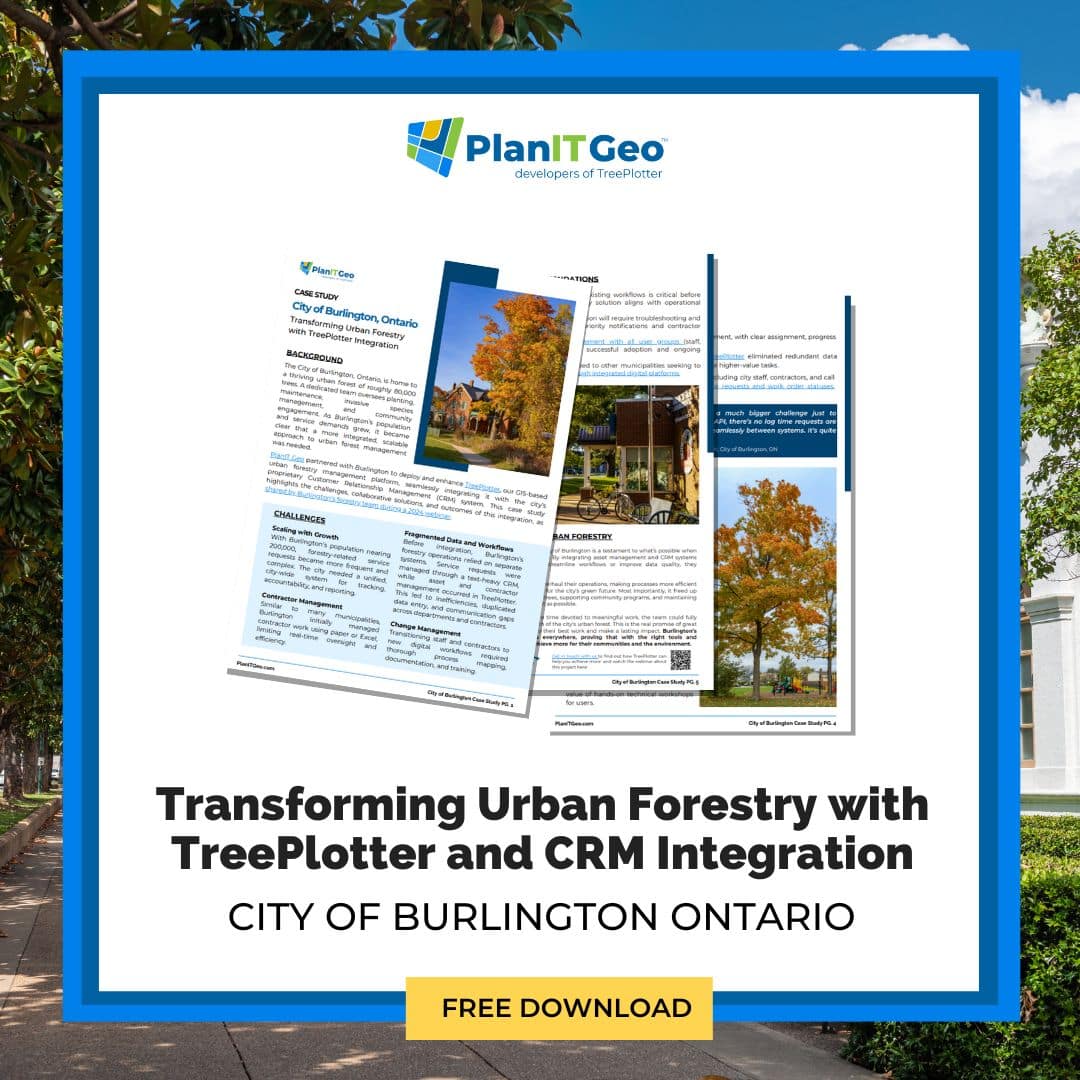City of Burlington: Transforming Urban Forestry with TreePlotter and CRM Integration
BACKGROUND
The City of Burlington, Ontario, is home to a thriving urban forest of roughly 80,000 trees. A dedicated team oversees planting, maintenance, invasive species management, and community engagement. As Burlington’s population and service demands grew, it became clear that a more integrated, scalable approach to urban forest management was needed.
PlanIT Geo partnered with Burlington to deploy and enhance TreePlotter, seamlessly integrating it with the city’s proprietary Customer Relationship Management (CRM) system. This case study highlights the challenges, collaborative solutions, and outcomes of this integration, as shared by Burlington’s forestry team during a 2024 webinar.
CHALLENGES
- Fragmented Data and Workflows
Before the integration, Burlington’s forestry operations relied on separate systems. Service requests were managed through a text-heavy CRM, while asset and contractor management occurred in TreePlotter. This led to inefficiencies, duplicated data entry, and communication gaps across departments and contractors. - Scaling with Growth
With Burlington’s population nearing 200,000, forestry-related service requests became more frequent and complex. The city needed a unified, city-wide system for tracking, accountability, and reporting. - Contractor Management
Similar to many municipalities, Burlington initially managed contractor work using paper or Excel, limiting real-time oversight and efficiency. - Change Management
Transitioning staff and contractors to new digital workflows required thorough process mapping, documentation, and training.
Planning the Integration and implementation
Process Mapping and Stakeholder Engagement
Led by Kyle McLaughlin and Laura Wright, Burlington’s forestry team conducted detailed process mapping to document every step in their service request and work order workflows. This was essential for both successful API development and organizational change management.
API Development
PlanIT Geo worked closely with Burlington’s IT and project management teams to create a two-way, inbound and outbound API between the city’s CRM and TreePlotter.
- Inbound: Service requests entered via CRM (by residents or call center staff) are automatically populated into TreePlotter, geo-referenced, and assigned to the appropriate team.
- Outbound: Status updates and notes made in TreePlotter are pushed back to the CRM, keeping residents and staff informed and eliminating duplicate work, which saves staff and the team 30 hours a week in data entry.
The integration process, including procurement, development, testing, and rollout, was completed over 18–24 months, with steady progress and ongoing teamwork making each stage manageable and rewarding. Additionally, Knowledge Base Articles (KBAs) were created for call center staff, ensuring consistent responses to public inquiries and facilitating smooth escalation to forestry experts as needed.
Day-to-day use of the integration
Digital Workflows for Program Management Contractors
- Service Requests: Residents submit requests (e.g., tree planting, pruning, removal) via the city’s online portal or call center. These requests are triaged and mapped in TreePlotter for field assessment.
- Work Orders: Verified requests are converted into actionable work orders within TreePlotter, assigned to city staff or contractors as appropriate.
- Contractor Portal: Contractors receive work orders directly through TreePlotter, limited to their assigned projects. They update completion status and notes, triggering the next steps in quality control (QC) and invoicing.
- Quality Control: Student staff or supervisors conduct field QC, updating TreePlotter with results. Failed items are automatically routed back to contractors for correction.
- Mass Updates and Reporting: At the end of each planting or maintenance cycle, bulk updates are performed in TreePlotter to record final tree attributes, warranty periods, and close out work orders. All data remains accessible for future reference and reporting.
Program Outcomes and Benefits
Operational Efficiency
- TreePlotter enables scalable tree care management, with clear assignment, progress tracking, and quality assurance workflows.
- Automated data flows between CRM and TreePlotter eliminated redundant data entry, reduced errors, and freed up staff time for higher-value tasks.
- Real-time visibility provides all stakeholders, including city staff, contractors, and call center personnel, up-to-date access to service requests and work order statuses, improving communication and accountability.
Enhanced Accountability and Reporting
- The integrated system empowers Burlington to quantify service demand, supporting budget requests and resource allocation. For example, the urban forestry department was able to demonstrate it receives more service requests than any other city department, strengthening its case for increased staffing and funding.
- TreePlotter’s integration supports community engagement and public-facing programs, such as tree giveaways and community planting events, with locations and progress tracked in real-time.
Change Management and Training
- Detailed process maps and KBAs ensure continuity despite staff turnover and support onboarding of new team members and contractors.
- The city’s experience underscores the importance of patience and iterative refinement during rollout, as well as the value of hands-on technical workshops for users.
Download the full case study for lessons learned, recommendations, and solutions.
If we didn’t have TreePlotter, it would be a much bigger challenge just to communicate across the board. Now, with the API, there’s no lag time requests are populated immediately, and all updates flow seamlessly between systems. It’s quite beautiful and smooth.
– Kyle McLaughlin, Supervisor of Forest Planning and Health, City of Burlington, ON

